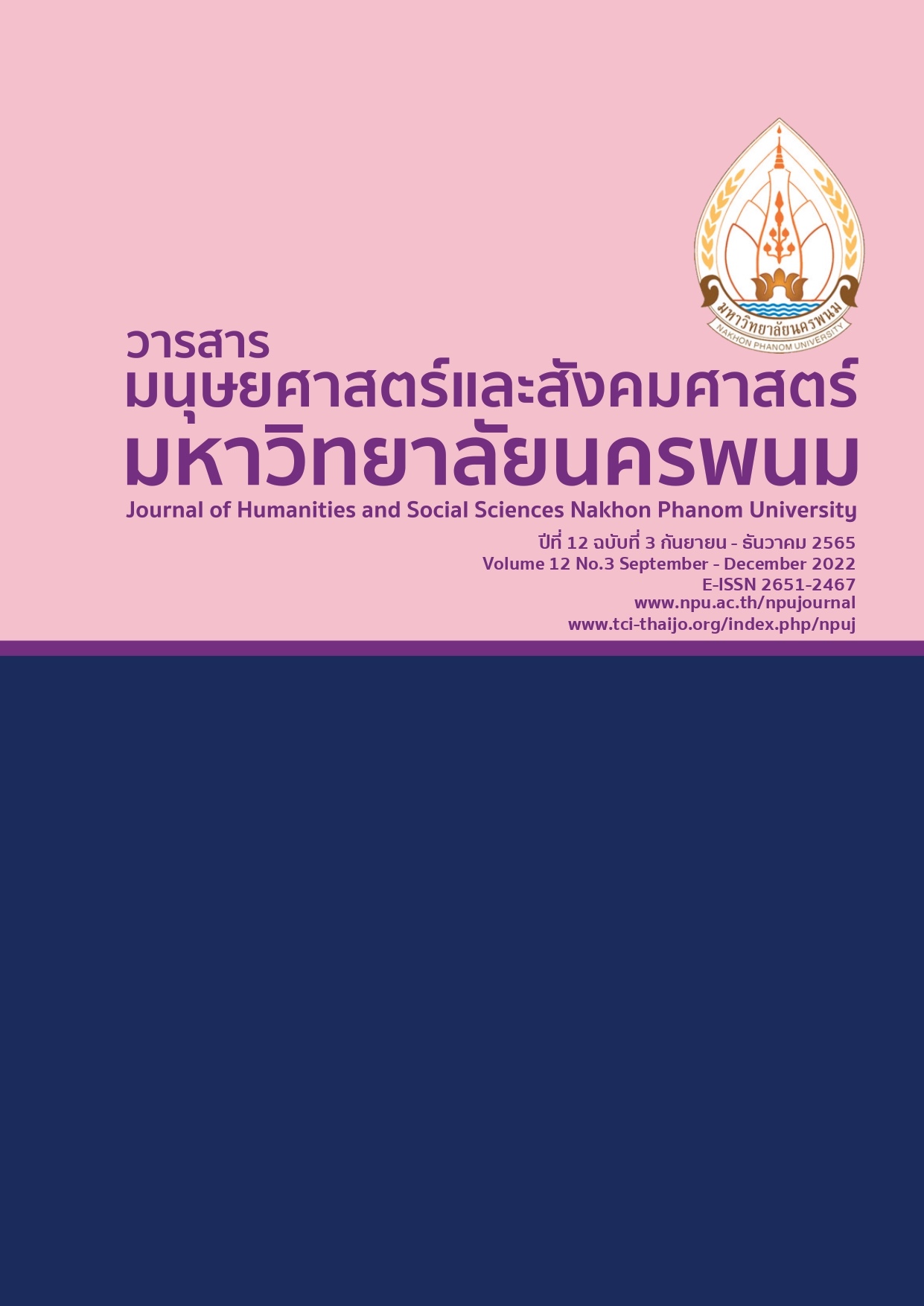ความได้เปรียบเชิงการแข่งขันของผู้ประกอบการด้านท่องเที่ยวเชิงวัฒนธรรมจังหวัดสกลนครจากการประกาศรับรองว่าเป็นเมืองหัตถกรรมโลกแห่งสีครามธรรมชาติ
Main Article Content
บทคัดย่อ
การวิจัยเรื่องนี้มีวัตถุประสงค์เพื่อศึกษาถึงปัจจัยที่ส่งผลต่อความได้เปรียบทางการแข่งขันด้านการท่องเที่ยวเชิงวัฒนธรรมของผู้ประกอบการและเพื่อวิเคราะห์กลยุทธ์การสร้างความได้เปรียบเชิงการแข่งขัน ผ่านการเก็บแบบสอบถามผู้ประกอบการที่เกี่ยวข้องในด้านการท่องเที่ยวเชิงวัฒนธรรมในจังหวัดสกลนคร จำนวน 370 ราย จากนั้นทำการวิเคราะห์ข้อมูลสถิติโดยใช้ ค่าเฉลี่ย และส่วนเบี่ยงเบนมาตรฐาน ขั้นตอนสุดท้ายทำการรวิเคราะห์ความสามารถเชิงการแข่งขันด้วยการวิเคราะห์สภาพองค์กร (SWOT Analysis) เพื่อกำหนดกลยุทธ์การสร้างความได้เปรียบเชิงการแข่งขัน ผลการวิจัยพบว่า 1) ด้านทรัพยากรการท่องเที่ยวเชิงวัฒนธรรม โดยรวมอยู่เกณฑ์ดี มีค่าเฉลี่ยเท่ากับ 3.57±0.95 ด้านการวางแผนบริหารจัดการ พัฒนาและนโยบาย โดยรวมอยู่ในระดับมาก มีค่าเฉลี่ยรวมทั้งหมดเท่ากับ 3.56±0.98 ปัจจัยที่ส่งผลต่อการขยายตัวในการรับรองให้จังหวัดสกลนครเป็น “เมืองหัตถกรรมโลกแห่งสีครามธรรมชาติ” โดยรวมอยู่ในเกณฑ์ดี มีค่าเฉลี่ยเท่ากับ 3.84±1.01 และปัจจัยด้านทรัพยากรสนับสนุนการท่องเที่ยวเชิงวัฒนธรรม โดยรวมอยู่ในระดับมาก มีค่าเฉลี่ยเท่ากับ 3.84±1.00 2) สามารถนำผลการวิเคราะห์สถิติมาใช้วิเคราะห์ กลยุทธ์การสร้างความได้เปรียบเชิงการแข่งขันได้ทั้งหมด 4 กลยุทธ์ คือ (1) กลยุทธ์การสร้างความแตกต่างด้วยการส่งเสริมรูปแบบการท่องเที่ยวเชิงสร้างสรรค์ เน้นการเรียนรู้ผ่านประสบการณ์จริง (2) กลยุทธ์การตอบสนองความต้องการของนักท่องเที่ยว จากการเชื่อมโยงการท่องเที่ยวระหว่าง กลุ่มสนุกและเครือข่ายผู้ประกอบการธุรกิจหัตถกรรมงานฝีมือ (3) กลยุทธ์การเพิ่มมูลค่า โดยการฝึกทักษะด้านการย้อมครามให้กับคนในพื้นที่ (4) กลยุทธ์การลดต้นทุนในการดำเนินงาน โดยใช้ชื่อเสียงการได้รับการประกาศและรับรองว่าเป็นนครหัตถศิลป์โลกเจ้าแห่งครามธรรมชาติสามารถลดต้นทุนค่าใช้จ่ายในการโฆษณา ประชาสัมพันธ์ได้ จากผลการวิเคราะห์และอภิปราย สามารถสรุปได้ว่า การได้เป็นเมืองหัตถกรรมโลกแห่งสีครามธรรมชาติ ส่งผลให้มีปริมาณนักท่องเที่ยวเพิ่มขึ้น จึงเป็นโอกาสในการพัฒนาการท่องเที่ยวเชิงวัฒนธรรมของจังหวัดสกลนคร สร้างความได้เปรียบเชิงการแข่งขันจากแหล่งท่องเที่ยวที่มีชื่อเสียงอื่นๆ ในภูมิภาคเดียวกัน
Article Details

This work is licensed under a Creative Commons Attribution-NonCommercial-NoDerivatives 4.0 International License.
References
Aaker, D. A. (2012). Building Strong Brands. New York : Simon & Schuster.
Chompukum, P. (2009). ʻOngkān læ kānčhatkān [Organization And Management]. Bangkok : McGraw-Hill
Cochran, W. G. (1953). Sampling Techniques. New York : John Wiley & Sons. Inc.
Department of Intellectual Property. (2019) Yon withī phā Thai phā yō̜m khrām Sakon Nakhō̜n [Visit Indigo Dye Fabric, Sakon Nakhon Province]. Retrieved May 2019, from http://www.bangkokbiznews. com/ pr/detail/13976
Duang-udom, W. et al. (2010). Konlayut kāntalāt læ kānprachāsamphan kānthō̜ngthīeo čhangwat chai nāt [Marketing strategies and public relations for tourism in Chainat Province]. Bangkok : National Research Council of Thailand (NRCT).
Gurel, M. and TAT, M. (2017). SWOT analysis: A Theoretical Review. The Journal of International Social Research. 10(51),1145-1154
Kalvet, T., Olesk, M., Tiits, M. and Raun, J. (2020). Innovative tools for tourism and cultural tourism impact assessment. Sustainability. 12(18),1-30. https://doi.org/10.3390/su12187470
Kotler, P. (2014). Marketing Management. (14th ed.). New Jersey : Prentice-Hall.
Kuncoro, W. and Suriani, W. O. (2018). Achieving sustainable competitive advantage through product innovation and market driving. Asia pacific management review. 23(3),186-192.
Longsheng, C., Shah, S. A. A., Solangi, Y. A., Ahmed, M. and Ali, S. (2022). An integrated SWOT-multi-criteria analysis of implementing sustainable waste-to-energy in Pakistan. Renewable Energy. 195(2022), 1438-1453. https://doi.org/10.1016/j.renene.2022.06.112
Matichon online. (2018). Saphā hatthasin lōk raprō̜ng Sakon Nakhō̜n pen [ World Craft City for Natural Indigo]. Retrieved August 2018, from https://www.matichon.co.th/news-monitor/news_865538
Moayerian, N., McGehee, N. G. and Stephenson Jr, M. O. (2022). Community cultural development: Exploring the connections between collective art making, capacity building and sustainable community-based tourism. Annals of Tourism Research. 93(2022),1-14. https://doi.org/10.1016/j.annals.2022.103355
Nakkasem, W. and Pasunon, P. (2018). Patčhai thī song phon tō̜ kānsāng khwām daiprīap thāngkān khǣngkhan khō̜ng phūprakō̜pkān thurakit bō̜rikān nai khēt Krung Thēp Mahā Nakhō̜n [Factors affecting the competitive advantage of service business entrepreneurs in Bangkok]. Veridian E-Journal, Silpakorn University (Humanities, Social Sciences and arts). 11(1),2148-2167.
Niyomkar, P. (2021). Kānphatthanā sinkhā thīralư̄k phā thō̜ mư̄ yō̜m khrām phư̄a phœ̄m mūnlakhā thāng sētthakit kānthō̜ngthīeo nai khēt thētsabān ืnakhō̜n Sakon Nakhō̜n [The Development of Indigo Dyed Hand Woven Cotton Souvenir Product For Value Added Tourism Economy in Sakon Nakhon]. Journal of Liberal Arts and Management Science. 8(2),76-89
Pakdeeronachit, Y. and Choibamroong, T. (2019). sakkayaphāp chumchon dān kān songsœ̄m kāntalāt kānthō̜ngthīeo kǣ lǣng thō̜ngthīeo dōi chumchon nai phư̄nthī phisēt mư̄ang Phatthaya læ phư̄nthī chư̄am yōng [Community Potential to Promote Tourism Marketing of Tourist Attractions by the Community in the Special Governed City-Pattaya and the Related Areas]. Journal of Social Innovation. 7(2),254-264
Pearce, J. A. and Robinson, R. B. (2011) Strategic Management: Formulation, Implementation and Control. New York : McGraw Hill.
Pon-ngam, P. (2018). Kānsāng mūnlakhā phœ̄m čhāk phūmpanyā phākhāomā nai čhangwat lœ̄i sū sētthakit sāngsan [Adding Value from Culture and Local Wisdom of Loincloth in Loei Province Toward Creative Economy]. KKU Research Journal of Humanities and Social Sciences (Graduate Studies). 7(3),146-158.
Porter, M. E. (1990). The Competitive Advantage of Nations. Harvard Business Review. 73-91
__________. (2008). The Competitive Advantage Creating and Sustaining Superior Performance. New York : The Free Press.
Richards, G. (2020). Designing creative places: The role of creative tourism. Annals of tourism research. 85(2020),1-11. https://doi.org/10.1016/j.annals.2020.102922
Saithong, A., Vanruengrong, T. and Sunaprom, U. (2012) Kānphatthanā rūpbǣp phāya ʻom khrām samrap khon run mai [The Development of Indigo-dyed Cloths' Pattern for the new Generation People]. Sakon Nakhon : Sakonnakhon Rajabhat University
Soonsan M. and Sungthong S. (2020). Phāplak prathēt læ phāplak lǣng thō̜ngthīeo khō̜ng Thai : mummō̜ng khō̜ng nakthō̜ngthīeo chāo tawantok [Causal Relationships between Destination Image, Place Attachment, Overall Satisfaction, and Behavioral Intention of Western Tourists in Phuket]. KKBS Journal of Business Administration and Accountancy. 4(2),119-140
Thanarungcharoenkit, et al. (2019). Konlayut kāndamnœ̄n thurakit phư̄a sāng khwām daiprīap thāngkān khǣngkhan khō̜ng thurakit rān Mr. Ice Cream čhangwat Nakhō̜n Pathom [Business Strategies for Creating Competitive Advantage of Mr. Ice Cream Restaurant, Nakhon Pathom Province]. Veridian E-Journal, Silpakorn University (Humanities, Social Sciences and arts). 10(1),1152-1167
Thongchern, P. (2009). Kārok lap mā khō̜ng sī khrām phāk ta [The return of the southern indigo]. Bangkok : The Thailand Research Fund.
Vanichbuncha, K. (2017). Kān wikhro̜ sathiti chan sūng dūai SPSS for Window [Advanced Statistical Analysis with SPSS for Window]. (12th ed). Bangkok : Lada limited partnership
World Crafts Council. (2021). Sakon Nakhon (Thailand). Retrieved August 2021, from https://www.wccinter national.org/sakonnakhon
Yampiw, C. and Sansook, C. (2021). Konlayut sētthakit sāngsan khō̜ng phūprakō̜pkān wisāhakit khanāt klāng læ khanāt yō̜m nai čhangwat Phra Nakhō̜n Sī ʻAyutthayā [Creative Economy Strategies of Small and Medium Enterprise Entrepreneurs in Phra Nakhon Si Ayutthaya Province]. Santapol College Academic Journal : SCAJ. 7(1),39-48.

